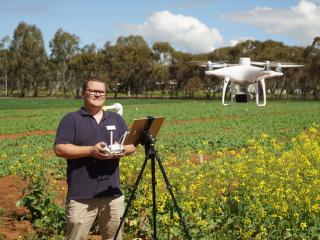Western Australia
April 1, 2021

DPIRD research scientist Dr Dustin Severtson is leading a Science Partnership project to examine the use of drones as a tool to assess crops for pest damage.
Crop surveillance from the skies is being explored as a means to improve pest management strategies by a new Grains Science Partnership project.
The Department of Primary Industries and Regional Development has joined with The University of Western Australia to test the use of high-tech drones with imaging technology to assess crops for damage.
Project lead, department entomologist Dustin Severtson said the technology was in its infancy and being adapted to the grains industry.
Dr Severtson said the project had acquired two of the latest high-tech cameras from the United States and China that are fitted to drones to live stream footage of plant health as they flew over the crop.
“The drones are fitted with normalised difference vegetation index, or NDVI, technology that provides a live video stream of crop damage,” Dr Severtson said.
“It uses the red and near-infrared part of the light spectrum to show leaf stress not seen by the naked eye.”
The drones will be in action in coming months, as crop emergence unfolds through to spring when the weather warms up.
The project will start by flying over cereal and canola crops in the central agricultural region in an attempt to pick up hotspots of pest infestation such as aphids.
The research team is collaborating closely with chief remote pilot and drone remote sensing researcher Nik Callow and precision agriculture/agronomy scientist Ken Flower, both from UWA, to refine the use of the technology and apply the data.
Dr Severtson said the drones and imaging technology provided a means to monitor crops on increasingly large grain properties so growers could optimise their pest scouting strategies.
“The aim is to take drone and mobile device technology and improve current crop monitoring to make pest and disease scouting easier and more accurate, saving on time and costs and creating more sustainable agriculture systems,” he said.
“We’re working towards skipping the expensive and time consuming multispectral image processing to access crops in real time to pick up areas that have unhealthy or stunted plants to target for possible pest infestation.
“It may seem all very ‘blue sky’ at the moment but this ‘augmented reality’ technology is already being used in high value crops, like viticulture, in the US and it is important WA’s grains industry is at the forefront of this rapidly advancing science.”
The project will also work on expanding the department’s CropScout app, which calculates the threshold required to spray canola for cabbage and turnip aphids.
A ‘sweep net’ module will be developed to determine the threshold for native budworm caterpillars in pulse crops and diamondback moth and native budworm in canola crops to assist growers’ treatment decisions.
“We’ve had great feedback about the CropScout smart phone app, which is a novel way to assess crops for pests and apply thresholds – there’s nothing else like it in the industry,” Dr Severtson said.
“This technology is also very new in terms of running pest sampling algorithms on an app and mapping results across properties.
“We are working to refine and apply the tools so that growers and consultants can use it easily in the field to tailor their integrated pest management strategies and protect the value of their crops.
“These are not technologies that are going to die out, they’re the way of the future.”